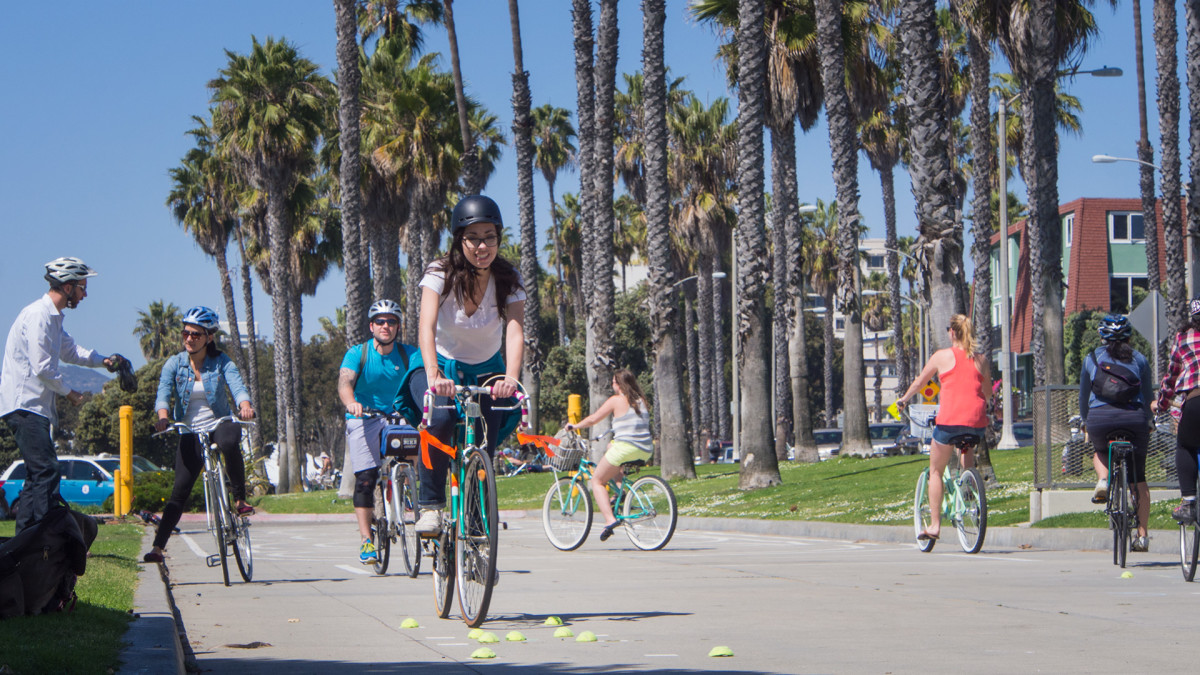
On Tuesday, Santa Monica could join the growing number of cities taking up the U.S. Department of Transportation Mayors’ Challenge to make streets safer for people.
“With citywide (and eventually regional) bikeshare coming this year, we must focus even more on safety, and how to create conditions and foster awareness such that we move toward the Vision Zero goal of no accidents, no deaths, no injuries.”
At the request of Mayor Kevin McKeown and Councilmember Pam O’Connor, the City Council Tuesday will consider accepting the U.S. DOT’s challenge, reaffirming the bayside city’s commitment to planning safer streets for all users while pushing for even more improvements like the upcoming Pedestrian Action Plan (you can let the Council know you support safer streets for all here).
“When I was first elected in 1998, one of the priorities I brought onto the Council was pedestrian safety,” McKeown said. “I helped push forward a phased rethinking of intersections and installation of safer crosswalks along all of our boulevards and in our neighborhoods. While that was an important step, there is much yet to be done to make our streets safe for everyone, from the senior shopping for groceries to the young student walking to school.”
According to the Santa Monica Police Department, over the last three years, the police have investigated 874 serious collisions that involved people walking or on bikes that resulted in death or injury.
“When I placed authorization for Santa Monica’s participation in the Challenge on the agenda, Councilmember O’Connor suggested we take the opportunity to reaffirm our commitment to pedestrian and bicycle safety in all our planning and mobility policies, and I agreed,” he said.
Next month, the city council is expected to look at Santa Monica’s first comprehensive zoning update in three decades. In that update are slated some significant improvements to the city’s streets, which is welcome news. According to the Santa Monica Police Department, over the last three years, the police have investigated 874 serious collisions that involved people walking or on bikes that resulted in death or injury. This was a point brought up by Planning Commissioner Richard McKinnon in 2014 when he ran for City Council.
“The zoning code we are about to adopt will encourage wider sidewalks and other pedestrian-oriented amenities, but when we finish the intensive work on the citywide zoning code, the other Pedestrian Action Plan goals can be defined and implemented,” said McKeown, who was in Washington, D.C. last week for the National League of Cities Congressional Conferences.
While in D.C., McKeown said, he was invited to give a presentation at the USDOT as part of the Mayors’ Challenge, an initiative by the agency’s director, Transportation Secretary Anthony Foxx.
The USDOT Mayors’ Challenge is designed to get local elected officials throughout the country to integrate better bike and pedestrian planning in their cities. It calls for leaders to take a “complete streets” approach, recognizing that streets should be safe for people of all ages and abilities, whether they are walking or biking.
Santa Monica has already had some success in creating shared streets, especially through implementing its Bike Action Plan three years ago.
“My presentation at USDOT was about what Santa Monica is already accomplishing to identify how streets can be effectively and safely shared among various forms of transportation. Our successes — with marked bike routes, traffic signals that sense the presence of cyclists, and provision of needed bike facilities from bike racks to the downtown Bike Centers — have already seen cycling increase 67% over a two-year period,” McKeown said.
“With citywide (and eventually regional) bikeshare coming this year, we must focus even more on safety, and how to create conditions and foster awareness such that we move toward the Vision Zero goal of no accidents, no deaths, no injuries,” he said.
“Pedestrians can be at even more risk than bicyclists, and we have the opportunity with our new Pedestrian Action Plan to make walking, even in Santa Monica’s most congested areas, safe for everyone from 8 to 80. When a city is designed to serve the young and the elderly, it tends to serve everyone well,” McKeown said.
